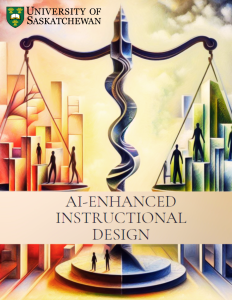Copyright and Licensing
AI-Enhanced Instructional Design is published under the Creative Commons Attribution-NonCommercial-ShareAlike 4.0 International License. According to the stipulations of the CC BY-NC-SA 4.0 license, those who utilize this work must give credit to the original creator. This license permits individuals to share, modify, and create derivatives of the content in any form or medium, strictly for noncommercial use. Additionally, if you wish to adapt or build upon this work, the resulting creation must be distributed under the same licensing terms.
Generative ai images
All the AI-generated images in this textbook have no copyright and are not eligible for copyright protection. At present, these AI-generated images are immediately released into the public domain under the CC0 1.0 Universal license. While there are numerous questions and complexities around openly sharing AI-generated content, we draw upon the principles and guidance of the Creative Commons organization, which advocates for the ethical and equitable sharing of knowledge and culture. As Kat Walsh (2023) articulates: “We encourage the use of CC0 for those works that do not involve a significant degree of human creativity to clarify the intellectual property status of the work and to ensure the public domain grows and thrives.”
For a deeper understanding of CC licensing concerning the outputs of generative AI, we suggest visiting the Creative Commons website and reviewing the recommended readings we have selected. If you wish to adapt any chapters from our textbook, we hope you will replace our AI-generated images with images you create or generate. We have provided the prompts for generating AI images to guide and inspire you.
ATTRIBUTION
When attributing derivatives of AI-Enhanced Instructional Design, please use the following attribution:
.
Desjardins, D., Drought, B., Fischl, B., Frampton, S., Giannios, M., Jodrey, H., Korchinski, K., MacDowell, P., Moser, S., Moskalyk, K., Neibrandt, J., Neufeld, P., Peters, A., Otegbade, T., Schindelka, A., Tide, D., Tilford, L., Tooke, K., & Washlowsky, M. (2023). AI-Enhanced Instructional Design. University of Saskatchewan. https://openpress.usask.ca/etad873aienhancedinstructionaldesign
Cover Image
The cover photo was generated by Meagen Giannios using Bing Image Creator.
.

Recommended Reading
Bozkurt, A. (2023). Generative AI, synthetic contents, Open Educational Resources (OER), and Open Educational Practices (OEP): A new front in the openness landscape. Open Praxis, 15(3), 178–184. https://doi.org/10.55982/openpraxis.15.3.579
Government of Canada. (2023). Consultation paper: Consultation on copyright in the age of generative artificial intelligence.
https://ised-isde.canada.ca/site/strategic-policy-sector/en/marketplace-framework-policy/consultation-paper-consultation-copyright-age-generative-artificial-intelligence#s23
Mills, A., Bali, M., & Eaton, L. (2023). How do we respond to generative AI in education? Open educational practices give us a framework for an ongoing process. Journal of Applied Learning & Teaching, 16(1), 16–30. https://doi.org/10.37074/jalt.2023.6.1.34

